


Experiments with magnets and conductors
Superconductors
Superconductivity was first noticed when liquid mercury was cooled to liquid Helium temperatures (4.2K) while its resistivity was being plotted. While approaching that temperature, the resistance was coming down linearly, when all of a sudden it dropped to zero Ohms! Dutch physicist Heike Kamerlingh Onnes was performing this experiment in 1911.
Since that time, other elements and combinations of elements have been shown to posses a superconducting state at various temperatures. This table shows the elements which become superconducting and the temperature at which it happens. Most research has been to find materials which are superconducting at higher temperatures. For example, the ceramics in kits you can buy become superconductors at about -186° C. Using liquid nitrogen (LN2) which is at -196° C, you can make that ceramic superconducting.
What is unique about a superconductor?
1. First, its resistance is really zero
Ohms, nothing, nada, all gone! This means that if current were flowing in
the material, it would produce no heat whatsoever.
2. Second, it will exclude any magnetic fields that come near it, like a magnetic mirror. If a north pole approaches the superconductor, the magnet will behave as though another magnet, just like itself, is approaching from the other side of the surface of the superconductor. At some distance, the magnet's north pole will start to repel the "other magnet's north pole", which is really a reflection of its own. It doesn't matter if it is a north or south pole, it will act the same way. This is the Meissner effect where a magnet will float, or levitate, above a ceramic of superconducting material.
If the magnet were sitting on the superconducting ceramic when it wasn't a superconductor, and then you started to cool the ceramic, when it becomes superconducting the magnet will start to lift up off of the ceramic and begin to levitate.
One problem, though, is that if the magnetic field of the current flowing within the superconductor becomes large enough, the ceramic will drop out of superconductivity, even if it is cold. Large magnetic fields will destroy the superconducting state. So, there is always a balance between the temperature, the magnitude of the magnetic field due to the current, and the molecular structure in determining the suitability of the superconductor for a particular application. There are always new things on the horizon, though.


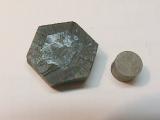
The above photos are the kit I purchased from Arbor Scientific. They have a complete kit, P8-9702, an economy kit, P8-9701, and a high density kit, P8-9715. The above is the high density kit. Edmund Scientific also has a kit, 38-169. Arbor includes some great notes and instructions with their kits. The kit was actually manufactured by Superconductive Components, Inc. Another is at: https://www.flinnsci.com/superconductivity---demonstration-kit/ap1489/
Another quality source for kits and information is at
http://www.can-superconductors.com/demonstration-kits.html.
They have an excellent site describing the history and explanation of this
phenomenon, and a description on how to make your own ceramic
superconductors! ![]()
The above kit comes with a petri dish, the two ceramics shown, and plastic (non-magnetic) tweezers. The lower density ceramic comes with a smaller NIB magnet, the higher density ceramic on the right comes with a larger NIB. The ceramics are about 1" diameter.
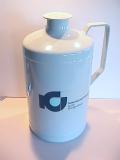
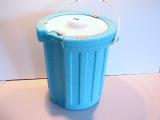
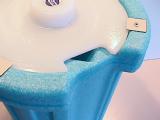
To carry the LN2, I have a dewar from International
Cryogenics (part number IC-5D), that holds 5 liters of LN2. When full,
the LN2 can last for up to 21 days in the dewar. I also have a dewar flask
made of HDPE that can hold 2 liters (from Electron
Microscopy Sciences as part number 62038-02, also available from Sargent
Welch as part number WLS-34755-B. A 90mm x 280mm glass dewar is
available from Labglass
as part number LG-7681-102), and has a large mouth, making it easy to submerse
objects. Remember, LN2 is very, very, very cold! Always, always wear
gloves and goggles when pouring it. Here is a table of various events and
the temperatures at which they happen, in Fahrenheit, Celsius, and Kelvin.
| Temperatures |
°F |
°C |
K |
| water boils |
212.0 |
100.0 |
373.2 |
| body temp |
98.6 |
37.0 |
310.2 |
| room temp |
77.0 |
25.0 |
298.2 |
| water freezes |
32.0 |
0.0 |
273.2 |
| mercury freezes |
-37.8 |
-38.8 |
234.4 |
| dry ice |
-108.4 |
-78.0 |
195.2 |
| liquid Oxygen |
-297.4 |
-183.0 |
90.2 |
| liquid Nitrogen |
-320.8 |
-196.0 |
77.2 |
| liquid Helium |
-452.1 |
-269.0 |
4.2 |
| absolute zero |
-459.7 |
-273.2 |
0.0 |
For this, K =
°C + 273.2
and
°F = (9/5) *
°C + 32
Experiment ![]()
Here are some photos of the magnets floating above the ceramics. Very cool!

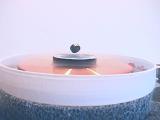
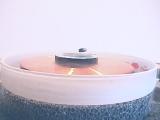
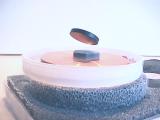
This shows the lower density ceramic with a couple of different magnets floating above it. I placed a copper disk, about 5/16" by 3" diameter, in the petri dish and placed the ceramic on top of that. Another demonstration is to drop the magnet onto the copper disk, watching it float downward at a slower than usual rate, then rest on the surface of the copper disk. This is an example of eddy currents.

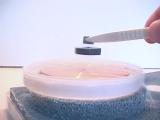
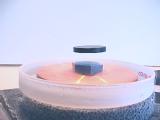
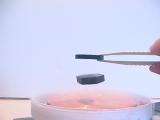
These are with the higher density ceramic, which will be suspended in the air if you lift the magnet as shown. The ceramic would also suspend the magnet under it if you flip them over. To use this ceramic, you need to have the magnet sitting on the ceramic as it cools to its superconducting state. Then pick up the magnet (the ceramic will come with it), hold it in the air for a few seconds, allowing the ceramic to warm up. As it does so, it will start to fall away from the magnet. You can then float the magnet above the ceramic, and it will be horizontal, not angled as with the other ceramic. The first photo in the next row shows that the magnet is floating about 10mm above the ceramic! This effect is called pinning, where there is some penetration of the magnetic field into the superconducting ceramic, different from the other ceramic which does not allow any penetration of the field.
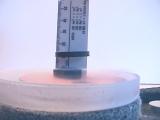

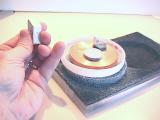
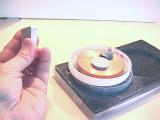
These three photos show how the fields of the magnets affect each other, even from a distance of about 15"! One magnet is floating above the high density ceramic, the other is in my hand which I rotate, causing the floating magnet to move around.
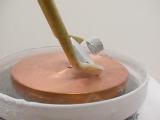
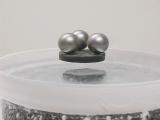
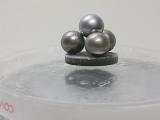
A very interesting effect I noticed was that when a small magnet was floating above the high density ceramic, it would stay in place even when the ceramic was tilted onto its edge! The next two photos show three and four steel ball bearings stuck to the magnet, floating above the high density ceramic, slowly rotating. Great effect! (I removed the copper disk for this one.)
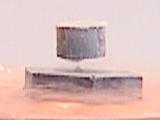
After several minutes, you will notice a liquid substance forming on the surface of the copper disk, and on the ceramic. You will also notice that when a magnet is close to that liquid, it will jump up to the magnet, then quickly evaporate! This liquid is oxygen which condenses out of the air onto the surface (same reason water condenses out of the air and onto a colder surface - like a cold glass of lemonade in the summer). Check the table above and see that oxygen becomes a liquid at a warmer temperature than liquid nitrogen. Interesting phenomenon, because liquid oxygen is paramagnetic, meaning that it is slightly attracted to stronger magnetic fields! In this photo, you can see the drop of liquid oxygen starting to form under the magnet on the ceramic, just before it jumps up to the magnet.
What good is this property of superconductivity? Here are some areas where this technology will be a help. (This information is from a display at the Franklin Institute of Science.)
1. Transmission of electrical power. Today, about 9% the power generated at the electrical power stations is wasted as heat in the wires which carry it from the station to the end user. If these wires were superconductors, there would be a tremendous savings. In addition, if the generators themselves used superconducting wires, that would be an even greater amount of savings.
2. In the area of medicine, MRI (magnetic resonance imaging) machines use powerful magnets to create the fields necessary to help physicians see into the body without having to perform surgery. Using superconductors would allow stronger magnets to be built, providing clearer pictures of various types of cells and tissues.
Another area is the production of SQUIDS which are magnetically sensitive sensors, sensitive enough to be able to detect electrical activity within the brain! They would be used to help diagnose and track changes in brain activity to determine if medicines or treatments are helping.
3. Future trains will use superconductors
to provide a method to levitate the train above the tracks, reducing friction
with the wheels, allowing the train to travel faster with less energy.
4. If computers used superconductors, then they could be made smaller, with smaller wires which would not heat up due to resistance, which would operate faster because the computer chips are closer to each other.
Other excellent resources:
http://superconductors.org/index.htm
http://www.nature.com/nature/links/001130/001130-3.html
http://www.cryomagnetics.com/home.htm